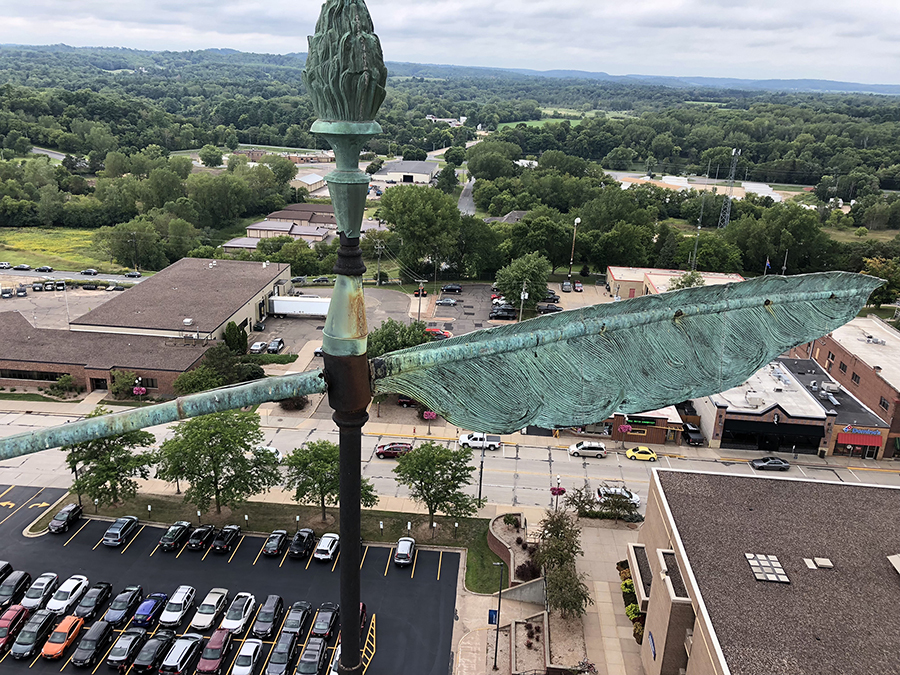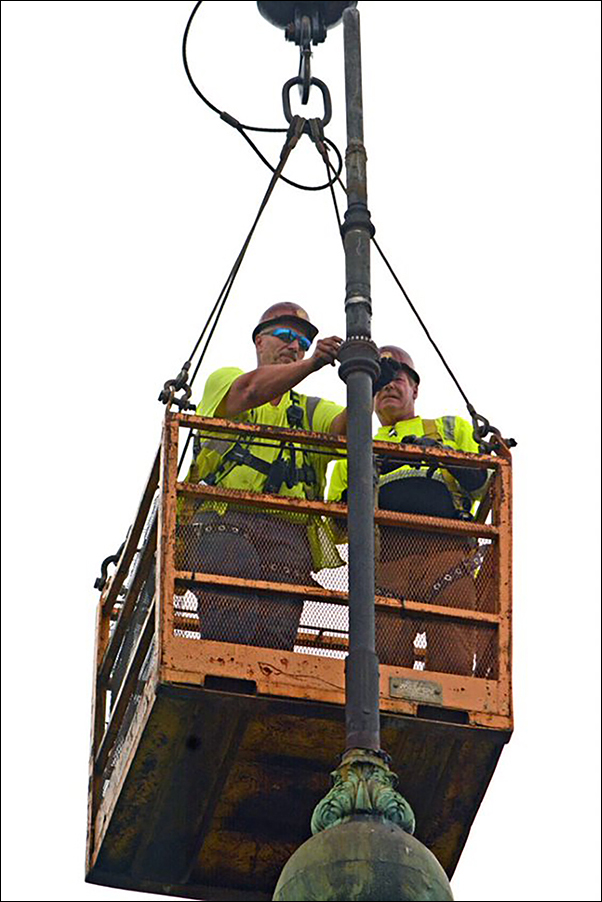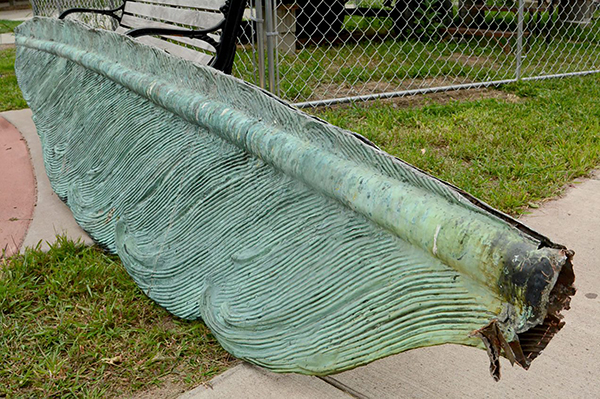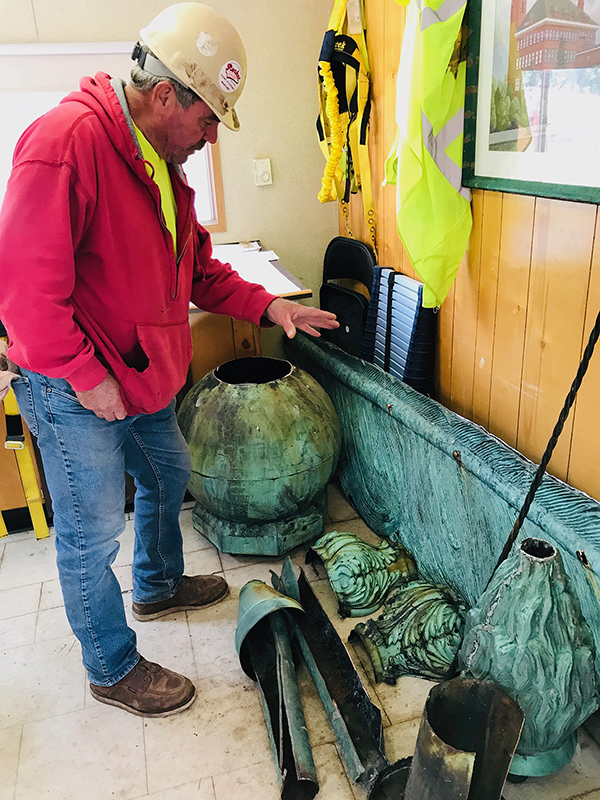For 121½ years, a copper weathervane shaped like a quill has perched atop the Clock Tower at University of Wisconsin-Stout — 135 feet above campus and downtown Menomonie.
The quill finally is getting a rest from the elements.
On Aug. 27, two workers with Building Restoration Corp. of Roseville, Minn., hung in a basket from a lift and slowly swung around the quill. They removed the molded flame — or torch — at the top of a lightning rod, then the quill just below and its support hardware.

After about 4½ hours and some mechanical challenges with rusted parts and a 75-pound lead-filled pipe, all of it was gently brought to the ground next to Bowman Hall, where workers hauled it away.
But not for long. The quill may return this fall, although it hasn’t been determined yet if it will be restored or replaced.
The work is part of an $8.95 million restoration project on Bowman Hall, the northeast corner of which is the Clock Tower. Most of the work is being done on the building’s exterior, including replacing about 30,000 worn bricks and installing new windows and doors.
 The work began in spring 2018 and has proceeded to the final stage, the upper part of the Clock Tower. Along with repairing and restoring the quill, the top of the tower will get a new, shiny copper roof this fall.
The work began in spring 2018 and has proceeded to the final stage, the upper part of the Clock Tower. Along with repairing and restoring the quill, the top of the tower will get a new, shiny copper roof this fall.
“Truthfully, I don’t think the quill would have lasted a whole lot longer, maybe two or three years,” said Joe Vaughan, BRC project foreman, pointing to rusting pipes that were part of the quill’s support system.
He was in the top of the Clock Tower, next to the bells, during the quill removal. The bells have been silenced, except for special occasions, during this phase of the project.
The quill is a “feather” about nine feet long and two feet high and a “pen” about 4½ feet long. The feather body consists of two scribed or ribbed copper plates welded together at the edges, but much of the welding had failed.
The molded flame, also about two feet high, along with an oval decorative piece at the base of the rod and other parts also will be restored or replaced, said Mike Bowman, a project manager for Facilities Management at UW-Stout.
 The experts, including preservation architects and restoration companies, are discussing the best options. The original construction documents called for restoration, including items such as straightening the ends of the feather, replacing clamps, lubricating parts and filling in holes in the copper.
The experts, including preservation architects and restoration companies, are discussing the best options. The original construction documents called for restoration, including items such as straightening the ends of the feather, replacing clamps, lubricating parts and filling in holes in the copper.
“Once the system was reviewed up close and on the ground, a decision was made to investigate the option of replacing it completely or whether it still can be restored,” Bowman said.
“It’s in pretty rough shape, and we want it to last another 100-plus years, so doing it the right way is important. We should know in the next couple of weeks what direction the experts suggest taking it,” Bowman said.
New support hardware for the quill will be made of stainless steel, which hadn’t been invented in 1897.
Erected in 1898
 The quill, for many years part of the university’s official logo, dates to 1898.
The quill, for many years part of the university’s official logo, dates to 1898.
Construction on Bowman Hall — then Stout Manual Training Institute — began in July 1897 and largely wrapped up in April of 1898. A report in the March 11, 1898, Dunn County News said the quill/weathervane was “soon to be erected on top of the tower.”
The building was constructed after fire burned down the previous facility, just four years old, and the adjoining high school on the same site Feb. 2, 1897, according to the university history book “An Idea Comes of Age: UW-Stout, 1891-1916.”
Bowman Hall was paid for by James Huff Stout, who founded the school in 1891. The Clock Tower was partially paid for by city residents, according to the book.
Choosing to top off the building with a quill, then a writing instrument dipped in ink, and a torch was James Stout’s statement about his belief in the “time-tested value of higher education,” the book said.
Bowman Hall is listed in the National Register of Historic Places.
###
Photos
Workers photographed the quill weathervane and torch, looking west over Broadway Street, atop UW-Stout’s 135-foot Clock Tower just before removing it in late August.
Two workers from Building Restoration Corp. hang from a basket during the effort to remove the quill and its support hardware. The project took 4½ hours.
The “feather” portion of the quill is about nine feet long and two feet high.
Joe Vaughan, Building Restoration Corp. foreman for the Bowman Hall project at UW-Stout, views the quill, torch and other parts, which will be restored or replaced.






